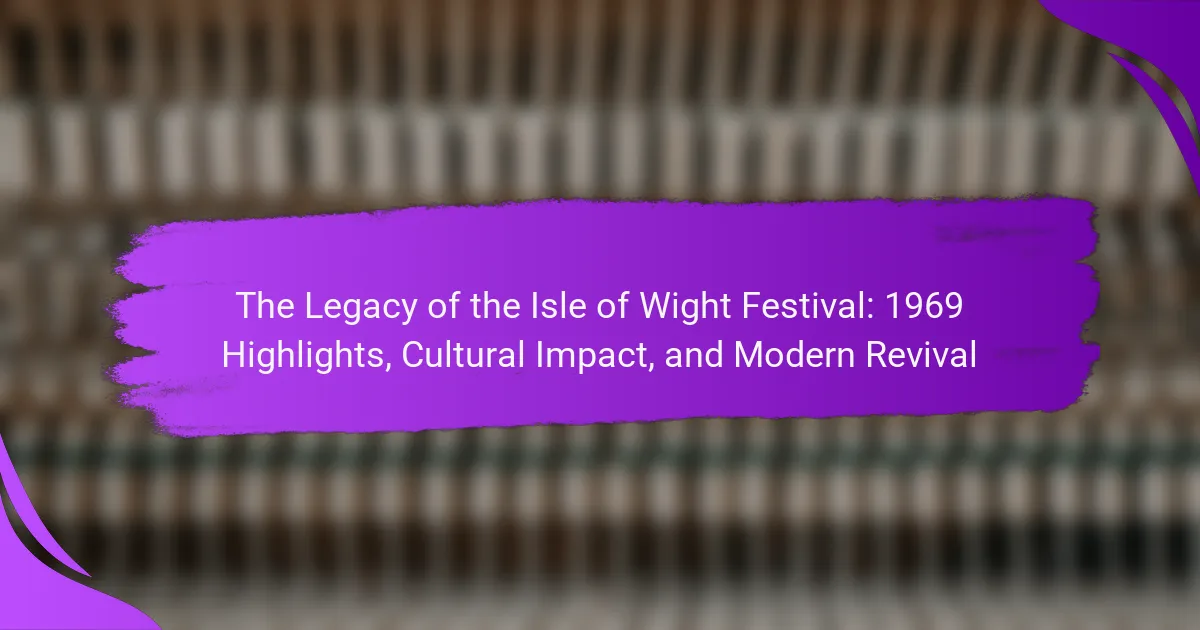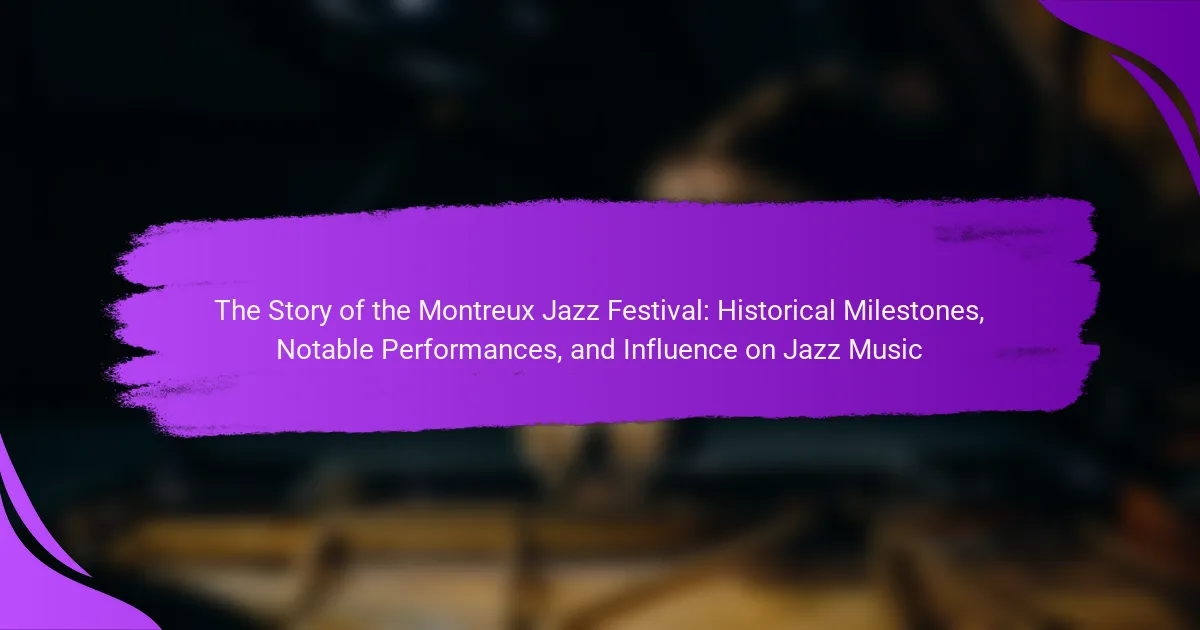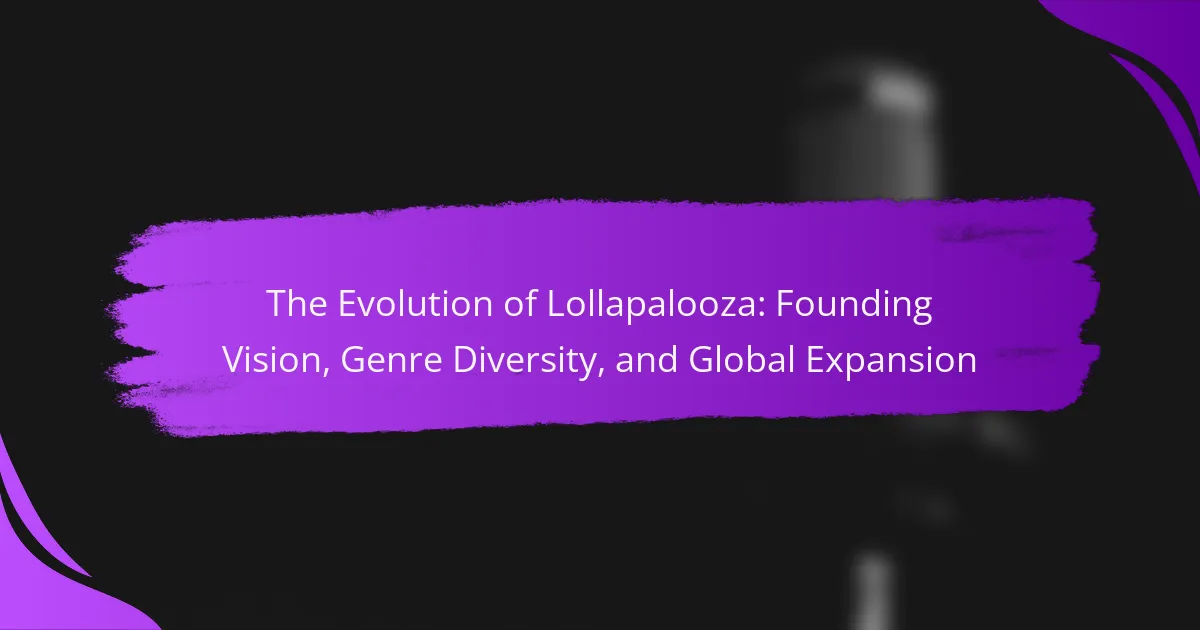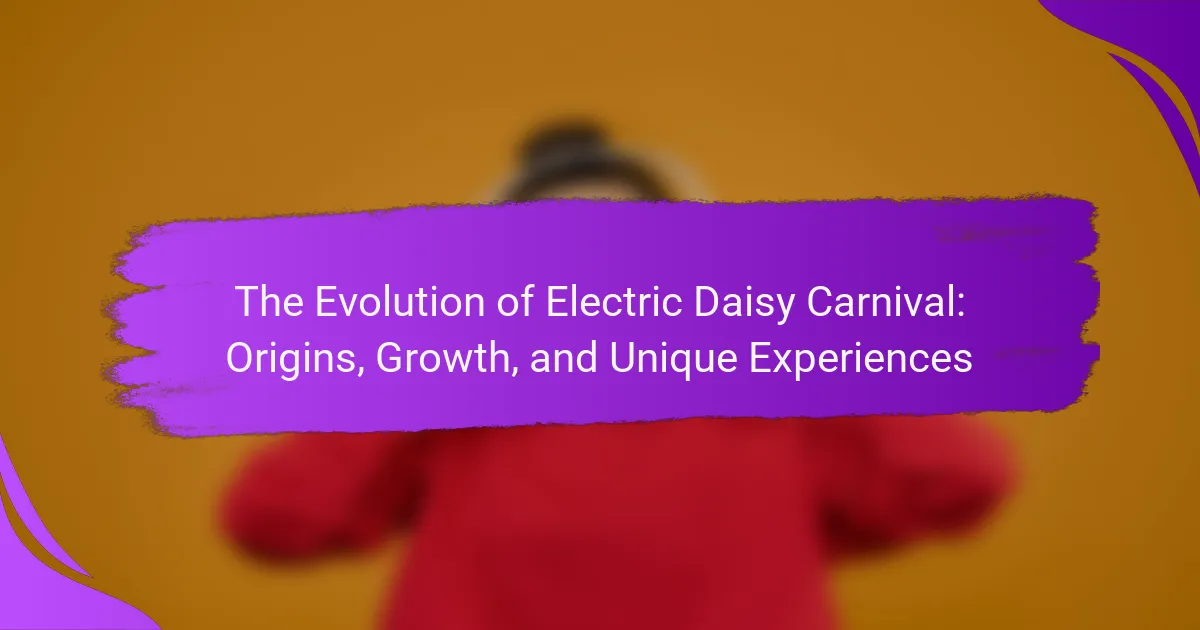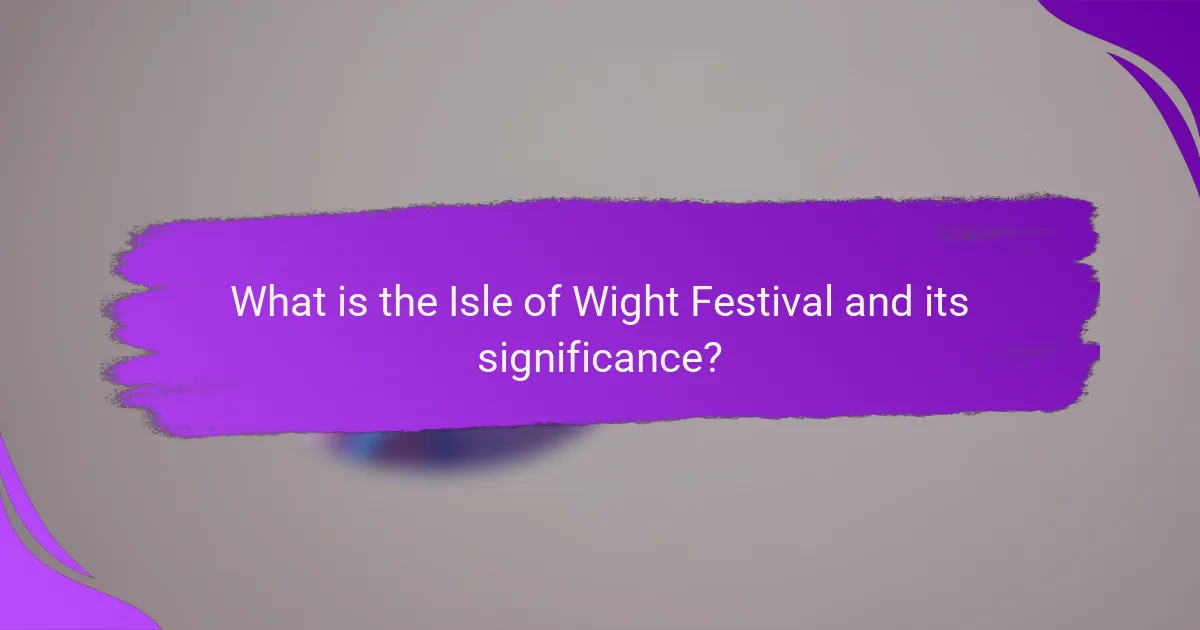
What is the Isle of Wight Festival and its significance?
The Isle of Wight Festival is a prominent music festival held annually on the Isle of Wight, England. It first took place in 1968 and gained significant fame in 1969. The 1969 festival featured iconic performances by artists such as Bob Dylan and The Who. This event is significant as it marked a pivotal moment in the history of music festivals. It attracted over 150,000 attendees, showcasing the counterculture movement of the 1960s. The festival’s legacy includes influencing future music festivals globally. It has undergone various revivals, continuing to celebrate music and culture today. The Isle of Wight Festival remains an important cultural landmark in British music history.
How did the Isle of Wight Festival originate in 1968?
The Isle of Wight Festival originated in 1968 as a music festival held on the island. It was created by a group of local promoters including Ray Foulk. The festival aimed to bring together various artists and music lovers. It featured prominent musicians such as The Who and Jimi Hendrix. The event took place at Ford Farm in Wootton, attracting around 10,000 attendees. The success of the festival in 1968 led to its continuation in subsequent years. The 1968 festival is often regarded as a precursor to the larger events that followed. Its legacy has influenced many music festivals around the world.
What were the key motivations behind its establishment?
The key motivations behind the establishment of the Isle of Wight Festival in 1969 were to create a platform for music and cultural expression. Organizers aimed to gather diverse artists and audiences in a unique setting. The festival sought to promote peace and love during a time of social upheaval. It also aimed to capitalize on the growing popularity of music festivals. The event was designed to showcase iconic performances and attract international attention. Additionally, the festival provided an opportunity for local businesses to thrive through tourism. The success of the 1969 festival set a precedent for future events and cultural gatherings.
Who were the initial organizers and performers involved?
The initial organizers of the Isle of Wight Festival in 1969 were Ray Foulk and his brother. They played a crucial role in establishing the festival as a significant music event. The primary performers included iconic artists such as Bob Dylan, The Who, and Jimi Hendrix. These performers contributed to the festival’s legendary status in music history. The festival attracted an audience of over 150,000 people, showcasing the era’s counterculture. This large turnout solidified its place in the cultural landscape of the time. The involvement of such notable artists and organizers marked a pivotal moment in music festivals.
What were the major highlights of the 1969 Isle of Wight Festival?
The major highlights of the 1969 Isle of Wight Festival included performances by iconic artists. Jimi Hendrix headlined the festival, delivering one of his last performances. The Who also played, showcasing their energetic style. Other notable acts included Bob Dylan, Joan Baez, and Ten Years After. The festival attracted around 150,000 attendees, marking a significant moment in music history. It was one of the largest music festivals of its time. The event helped to establish the Isle of Wight as a major location for music festivals. Its cultural impact continues to influence festivals today.
Which iconic artists performed at the 1969 festival?
The iconic artists who performed at the 1969 Isle of Wight Festival included Jimi Hendrix, The Who, and Bob Dylan. Jimi Hendrix headlined the festival, delivering one of his last performances. The Who showcased their rock anthems, captivating the audience. Bob Dylan made a significant return to the stage after years of absence. Other notable acts included Joan Baez and Leonard Cohen. The festival attracted an estimated 150,000 attendees. It is remembered as a pivotal moment in music history.
What memorable moments defined the 1969 festival experience?
The 1969 Isle of Wight Festival is defined by several memorable moments. Notably, Bob Dylan’s surprise performance marked his return to the stage after a three-year hiatus. This event drew significant media attention and excited fans. Additionally, the festival featured iconic performances by artists such as Jimi Hendrix and The Who. Hendrix’s rendition of “The Star-Spangled Banner” became legendary and symbolized the era’s counterculture. The festival also attracted an estimated 150,000 attendees, showcasing its massive popularity. The atmosphere was characterized by a spirit of peace and love, reflecting the cultural movements of the time. This festival set the stage for future music festivals, influencing the festival culture that followed.
How did the 1969 Isle of Wight Festival impact music and culture?
The 1969 Isle of Wight Festival significantly impacted music and culture by showcasing legendary performances and fostering a sense of community. Notable artists like Jimi Hendrix and The Who headlined the festival, attracting over 150,000 attendees. This event marked one of the last large-scale festivals of the 1960s counterculture movement. The festival solidified the concept of music festivals as major cultural events. It also influenced future festivals with its organization and scale. The festival’s atmosphere encouraged social and political discussions among attendees. Additionally, it reflected the growing youth culture and the desire for artistic expression during that era. The legacy of the Isle of Wight Festival continues to inspire contemporary music festivals worldwide.
What influence did the festival have on the music scene of the time?
The Isle of Wight Festival significantly influenced the music scene of its time. It showcased iconic performances from legendary artists like Jimi Hendrix and The Who. This exposure helped popularize rock music and shaped the festival culture. The event attracted a massive audience, with over 150,000 attendees in 1969. This large turnout demonstrated the growing demand for live music experiences. The festival also encouraged the emergence of other music festivals worldwide. It set a precedent for future events in terms of production scale and artist lineups. Overall, the Isle of Wight Festival played a crucial role in defining the music landscape of the late 1960s.
How did the festival reflect the social movements of the late 1960s?
The Isle of Wight Festival in 1969 reflected the social movements of the late 1960s by serving as a platform for countercultural expression. It showcased a diverse lineup of artists advocating for peace, love, and social change. Prominent performers included Jimi Hendrix and Joan Baez, who were influential figures in the anti-war movement. The festival attracted a large, youth-oriented audience that embodied the spirit of rebellion against traditional norms. Attendees participated in a communal atmosphere, emphasizing unity and social justice. The event highlighted issues such as civil rights and anti-establishment sentiments. With over 150,000 attendees, it became a significant cultural milestone. This gathering symbolized the culmination of the decade’s social upheaval and the desire for a more inclusive society.
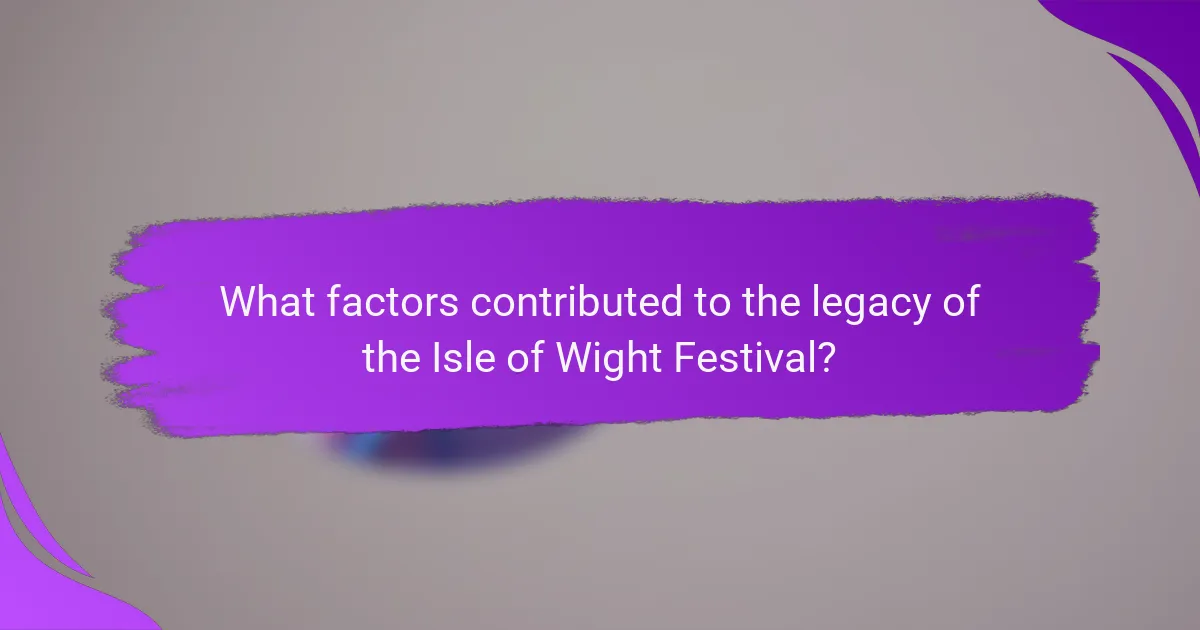
What factors contributed to the legacy of the Isle of Wight Festival?
The legacy of the Isle of Wight Festival is shaped by its historical significance, iconic performances, and cultural influence. The festival, particularly in 1969, hosted legendary artists like Bob Dylan and Jimi Hendrix. This attracted a massive audience, with over 600,000 attendees, marking it as one of the largest music festivals of its time. The festival’s location on the Isle of Wight added to its allure, providing a unique backdrop for performances. Additionally, it became a symbol of the counterculture movement, reflecting the social changes of the 1960s. Its impact on music festivals is profound, inspiring future events worldwide. The revival of the festival in the 2000s further solidified its legacy, reconnecting new generations with its rich history.
How has the festival evolved over the decades?
The Isle of Wight Festival has evolved significantly since its inception in 1968. Initially, it was a small gathering featuring iconic acts like Jimi Hendrix and The Who. Over the decades, it transformed into a major music event attracting large crowds. In the 1970s, the festival faced challenges, leading to its temporary discontinuation. It was revived in 2002, featuring a more diverse lineup and modern production values. The festival now includes various genres beyond rock, appealing to a broader audience. Attendance has grown from a few thousand to over 60,000 attendees in recent years. The festival also emphasizes sustainability and community engagement, reflecting contemporary values.
What changes have occurred in the festival’s format and audience?
The Isle of Wight Festival has evolved significantly in its format and audience. Originally, the festival featured a free-spirited, countercultural atmosphere with a focus on rock music. Over the years, it shifted to a more commercialized model, incorporating diverse genres and ticketed entry. The audience has also transformed; early attendees were predominantly young and countercultural. Today, the audience includes a wider demographic, with families and older generations attending. This change reflects broader societal trends and the festival’s efforts to appeal to a larger market. The introduction of various amenities and experiences has further attracted a more diverse crowd.
How have different generations perceived the festival’s legacy?
Different generations have perceived the Isle of Wight Festival’s legacy through varied lenses shaped by cultural context. Baby boomers often view it as a pivotal moment in music history, celebrating the festival’s role in the counterculture movement of the 1960s. Generation X tends to appreciate the festival’s nostalgia while recognizing its influence on modern music festivals. Millennials often see the festival as a symbol of cultural revival, focusing on its modern iterations and their connection to social issues. Generation Z views the festival through the lens of sustainability and inclusivity, emphasizing the need for environmental consciousness in event planning. Each generation’s perception reflects its unique social and cultural experiences, illustrating the festival’s evolving significance over time.
Why is the Isle of Wight Festival considered a cultural landmark?
The Isle of Wight Festival is considered a cultural landmark due to its historical significance and impact on music culture. First held in 1968, it became iconic with its 1969 edition featuring legendary performances. Artists like Jimi Hendrix and The Who played pivotal roles in shaping its reputation. The festival attracted over 150,000 attendees, showcasing the era’s counterculture. It symbolized the spirit of the 1960s and 1970s music movements. The festival’s revival in 2002 further solidified its status as a cultural touchstone. It continues to influence contemporary music festivals globally.
What role did the festival play in shaping the counterculture of the 1960s?
The festival played a significant role in shaping the counterculture of the 1960s. It served as a gathering point for youth seeking alternative lifestyles. The Isle of Wight Festival showcased prominent artists like Bob Dylan and Jimi Hendrix, amplifying their messages of peace and love. This exposure helped solidify the festival as a symbol of freedom and creativity. The event attracted over 150,000 attendees, demonstrating the widespread appeal of countercultural ideals. It also highlighted the growing disconnect between mainstream society and the youth movement. The festival’s atmosphere fostered a sense of community among attendees. Ultimately, it became a defining moment in the evolution of the 1960s counterculture.
How has the festival influenced future music festivals worldwide?
The Isle of Wight Festival has significantly influenced future music festivals worldwide by setting new standards for large-scale events. It popularized the concept of multi-day festivals, allowing attendees to enjoy a variety of performances over several days. The festival’s emphasis on a diverse lineup introduced the idea of genre-blending, encouraging future festivals to feature artists across different musical styles. Additionally, its massive attendance of over 150,000 people demonstrated the potential for large crowds, inspiring similar events globally. The festival also highlighted the importance of location, as its picturesque setting attracted attendees and enhanced the overall experience. Its pioneering spirit and legacy have encouraged subsequent festivals to prioritize unique themes and immersive environments. The impact of the Isle of Wight Festival can be seen in the evolution of iconic festivals like Glastonbury and Coachella, which adopted many of its innovative practices.
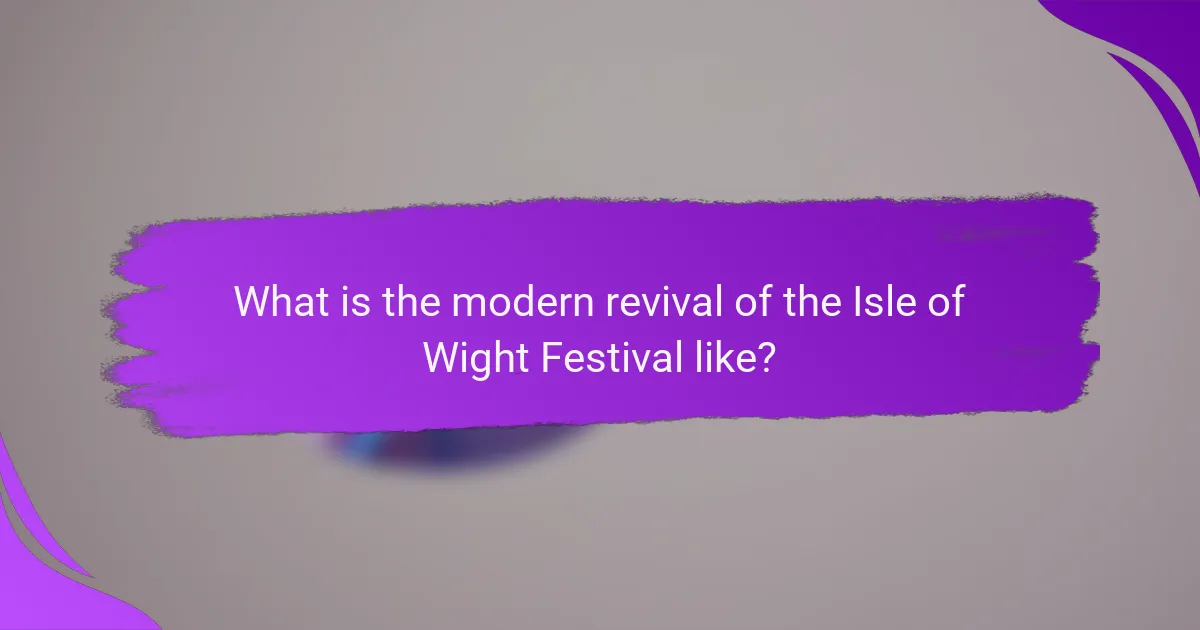
What is the modern revival of the Isle of Wight Festival like?
The modern revival of the Isle of Wight Festival is vibrant and diverse. It features a mix of established and emerging artists. The festival attracts a wide audience, celebrating various music genres. Attendance has grown significantly since its revival in 2002. The event now includes numerous stages and activities beyond music. It emphasizes sustainability and community engagement. The festival also showcases local food and crafts. It continues to honor its historical roots while evolving with contemporary trends.
How does the current festival compare to its historical counterparts?
The current Isle of Wight Festival features a broader range of musical genres compared to its historical counterparts. Historically, the festival primarily showcased rock and folk music, with iconic performances from artists like Jimi Hendrix and The Who in 1969. In contrast, modern iterations include pop, electronic, and indie music, reflecting current musical trends. Attendance has also significantly increased, with over 60,000 attendees in recent years, compared to around 150,000 in 1969. The festival now incorporates diverse cultural experiences, including art installations and food markets, which were less prominent in the past. Additionally, the current festival emphasizes sustainability and eco-friendliness, a response to contemporary environmental concerns. Overall, the evolution of the Isle of Wight Festival demonstrates a shift towards inclusivity and modernity while honoring its rich legacy.
What are the key differences in lineup and production today?
Today, the lineup of festivals like the Isle of Wight Festival features a more diverse range of genres compared to 1969. Modern festivals include artists from pop, electronic, and hip-hop backgrounds, reflecting current musical trends. In contrast, the 1969 lineup primarily showcased rock and folk artists.
Production techniques have also evolved significantly. Today’s festivals utilize advanced sound systems and lighting technology, enhancing the overall experience. In 1969, production was limited to basic sound equipment and less sophisticated stage setups.
Additionally, modern festivals often incorporate elaborate stage designs and visual effects, which were not common in 1969. Current events also focus on audience engagement through interactive experiences, a concept that was less emphasized in the past.
Overall, the differences in lineup and production today highlight the evolution of music and technology in festival culture.
How has the festival adapted to modern music trends?
The Isle of Wight Festival has adapted to modern music trends by incorporating diverse genres and contemporary artists. In recent years, the festival has featured popular acts from various genres, including pop, rock, and electronic music. This shift reflects the changing tastes of festival-goers. The lineup now includes both established artists and emerging talents. Collaborations with digital platforms have expanded its reach to younger audiences. Additionally, the festival has embraced social media for promotion and engagement. These adaptations ensure the festival remains relevant in the evolving music landscape.
What challenges does the Isle of Wight Festival face in the present day?
The Isle of Wight Festival faces several challenges today. One significant challenge is competition from other music festivals. Many festivals now offer diverse lineups and unique experiences. This makes it harder for the Isle of Wight Festival to attract attendees.
Another challenge is logistical issues related to transportation. The festival’s location on an island complicates access for visitors. Additionally, weather conditions can impact attendance and overall experience.
Financial sustainability is also a concern. Rising costs for artists and production can strain budgets. The festival must continually innovate to maintain its relevance and appeal.
Lastly, the festival faces pressure to adapt to changing audience preferences. Attendees increasingly seek more than just music, emphasizing experiences and amenities. These challenges require strategic planning to ensure the festival’s continued success.
How do economic factors affect the festival’s sustainability?
Economic factors significantly impact the sustainability of the festival. Funding sources, such as ticket sales and sponsorships, directly influence the festival’s financial health. Higher ticket prices can deter attendance, reducing revenue. Conversely, affordable pricing can increase attendance but may lower profit margins. Economic conditions, like recession, affect disposable income and spending on leisure activities. In 2019, the Isle of Wight Festival reported a 10% drop in attendance due to economic downturn concerns. Additionally, local economic conditions influence vendor participation and operational costs. A strong local economy can enhance support for the festival, while economic struggles may lead to decreased community involvement. Thus, economic factors play a crucial role in determining the festival’s long-term viability.
What role does technology play in the festival’s evolution?
Technology plays a crucial role in the evolution of festivals like the Isle of Wight Festival. It enhances the overall experience for attendees through improved sound and lighting systems. High-quality audio equipment allows for clearer performances. Advanced lighting technology creates immersive atmospheres. Additionally, social media platforms enable real-time engagement and promotion. Live streaming technology allows remote audiences to participate. Data analytics helps organizers understand attendee preferences. Ticketing systems have also become more efficient with digital solutions. These advancements contribute to the festival’s growth and adaptability over time.
What tips can attendees consider for enjoying the Isle of Wight Festival?
To enjoy the Isle of Wight Festival, attendees should plan their travel and accommodation in advance. The festival attracts large crowds, so booking early ensures better options. Attendees should also pack essentials like sunscreen, comfortable clothing, and sturdy footwear. Staying hydrated is crucial, as outdoor events can lead to dehydration. Familiarizing oneself with the festival layout helps in navigating stages and amenities efficiently. Checking the lineup schedule allows attendees to prioritize performances of interest. Engaging with fellow festival-goers enhances the experience through shared enjoyment. Lastly, embracing the festival’s atmosphere and being open to new experiences can lead to memorable moments.
The Isle of Wight Festival is a significant music event that first took place in 1968, gaining fame in 1969 with iconic performances from artists such as Jimi Hendrix and Bob Dylan. This article explores the festival’s historical significance, highlighting its role in the counterculture movement of the 1960s and its influence on future music festivals worldwide. It covers the festival’s evolution over the decades, its modern revival, and the challenges it faces today, while also examining the cultural impact and memorable moments that define its legacy. Key aspects include the festival’s diverse lineups, technological advancements, and the changing audience demographics that shape its ongoing relevance.
